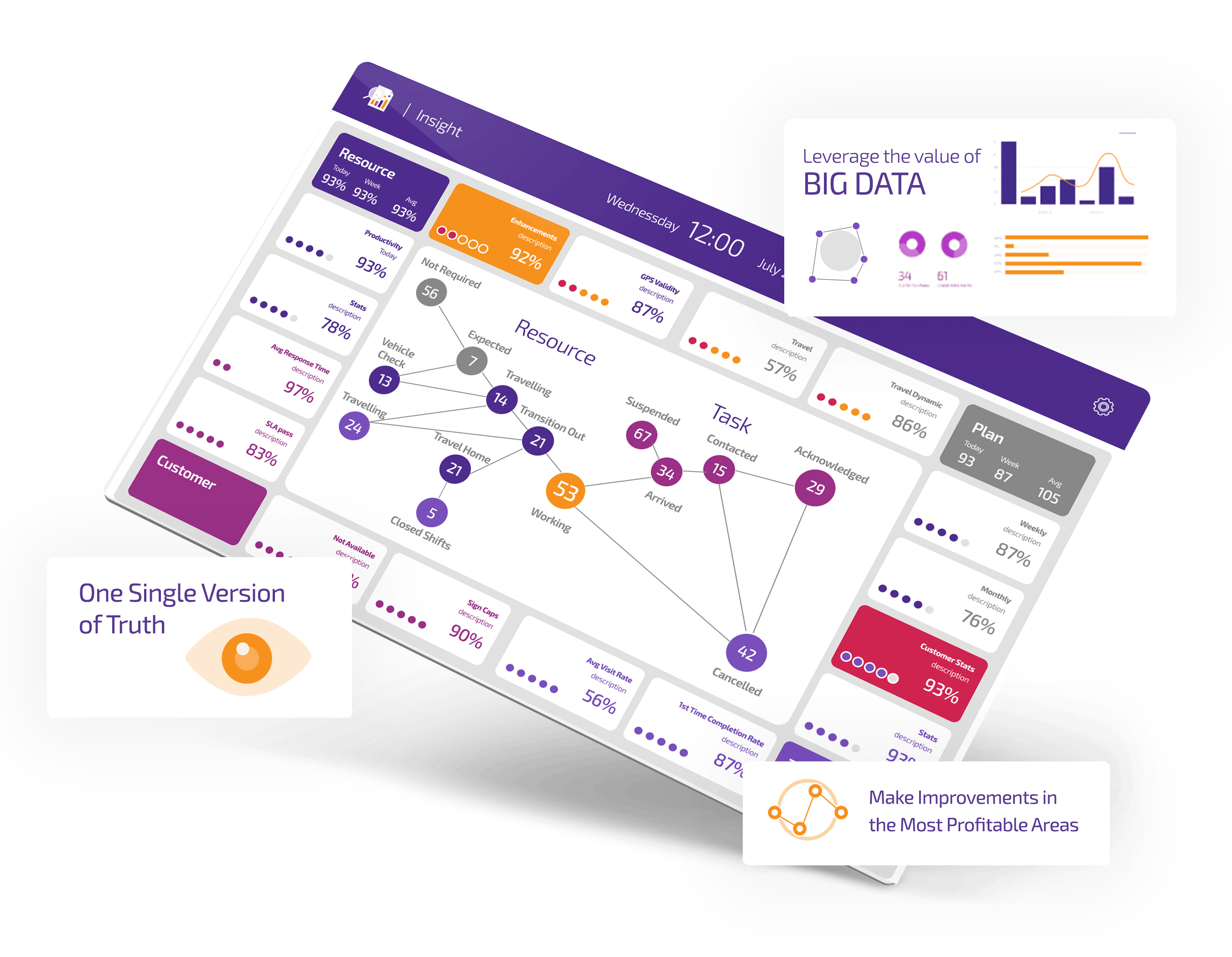Field service & operational intelligence
The game is changing, are you ready? That’s a scary sounding question, and it’s not just sensationalism for the sake of it. The widespread investment in and processing of big data by field service companies is revealing a big problem: many organizations lack the skills, resources and technology needed to extract value from large volumes of big data. This creates a self-replicating and familiar sounding problem. We require more data to facilitate important decision-making; we have too much data to feasibly process in a timely manner which is now out of date. Any organization that has a large, field-based workforce understands the challenge of staying in control of service delivery as it occurs. Historical data, and the inability to process it, is a motivating factor in organizational inertia. Inertia for field service organizations is a barrier between recording significant operations intel and being able to take action.
This all sounds pretty blue. If only there was a data analytics methodology which gathers & interprets real-time performance data from a range of sources within an organization and served it to key users at the right time in an actionable format… that mouthful is Operational Intelligence (OI) and this article is going to define what OI is and why you need it.
Defining Operational Intelligence
When was the last time you asked yourself what makes one business more successful than the next? More specifically, what makes one organisation with field operations more efficient, more profitable & more satisfactory to their customers than the next? If you’re like us, you think about these things with the same cadence as where you’re going to get your next coffee fix from.
A significant degree of field operation success comes down to making correct decisions at the right time. Decisions based on recent, complete data sets streamed from across an organization. This is Operational Intelligence (OI) in action, providing a live view of ongoing field operations and delivering insights to key decision makers at the moment it is required. This unprecedented view of key performance analytics reduces the time between intelligence being recorded & interpreted and action being taken. Unlike traditional Business Intelligence (BI), Operational Intelligence leverages real-time data rather than historical. OI has ushered in a new era of organisational decision making, picking up where Business Intelligence (BI) drops off. For more on this, check out our Operational Intelligence vs. Business Intelligence article.

Why Operational Intelligence?
So far this sounds like a lot of hype, but it is substantiated. Operational Intelligence (OI) solutions facilitate recording and delivering real-time performance insights to managers who can pursue immediate action. In a widespread field service organisation, such as a shipping company, OI enables management to stay in control of often uncontrollable changes to service capacity. Some issues can be handled discretely before they have even arisen using predictive analytics; employee productivity can be maximized with dynamic resource allocation throughout the working day. In the next section, we are going to define the desirable features of a complete field service intelligence solution for organisations undertaking a digital transformation.
How does Operational Intelligence work?
OI solutions use real-time data analysis in conjunction with data processing to quickly determine improvement opportunities and threats at various levels of field operations. This is OI in a nutshell, and the following are the key technologies a complete solution empowers management with:
1. Real-Time Monitoring
Real-time monitoring is what makes an OI solution unique from a Business Intelligence (BI) solution. OI solutions continuously monitor data sources from across an organization. Solutions, such as ‘Insight’, enable management to continuously review all field performance as it happens. This is OI’s fundamental feature, with service alerts supplied within seconds of a significant event occurring. The tolerances of a ‘significant event’ are defined by the management of an organization.
2. KPI & SLA Compliance
An OI solution utilises business analytics and real-time monitoring of KPIs / SLAs to alert management of lapsing service completion. By monitoring and alerting management to KPI/SLA adherence as the working day progresses, organisations can react accordingly and prioritise work in good time. This mitigates against the risk of fines and eases pressure on workers who must complete tasks without compromising their health or the quality of completed work. This is a subset of…
3. On-demand Report Generation
OI solutions empower managers with a live dashboard and the ability to run reports for presenting information to others on the fly. This allows for reports and performance data to be easily shared, giving a bigger picture of the current environment to those who can make decisions based on this. The best OI solutions provide reporting which is usable by regular employees, not just data scientists (even if the end result involves going into space…)
4. Obsolescence Monitoring
Operations intelligence can be applied to several industrial contexts to uncover obsolescence ahead of time. This links with predictive analytics and can be used to make informed decisions on work to be carried out without the need for a specific inspection. In the context of facilities management, this can combine tolerances with product lifespan estimates to inform service technicians of work to be completed and the parts required for a job without the need for repetitive visitation. This makes for far more efficient resource allocation and boosts end-customer satisfaction by scheduling in obsolescence-based contract work around a seamless schema of work.
5. Predictive Analytics
Predictive analytics is less a function of OI, but rather the next step-up in an operational intelligence solution. Predictive analytics means that OI is exclusively for short-term benefits. Instead, OI uses predictive analytics to derive trends and insights from historic service delivery. This allows recurring trends and possible repeat problems, or service inefficiencies, to be uncovered. With these deeper insights revealed, they are applied to a data model which provides managers with recommendations on operational and employee performance. Each of these recommendations is typically supported with evidence of how the change is projected to positively impact future service delivery and deliver greater value.
It’s these recommendations that drive transformational change. Managers are provided with a clearer image of service direction, enabling decisions to be made that ensure positive outcomes. This enhances the efficiency of your workforce and boosts satisfaction while increasing profit through the improved use of resources.
Benefits of Operational Intelligence
We may be guilty of alluding to the benefits of operational intelligence in the paragraphs above… Ultimately, OI provides crucial insights into a company’s inner workings. This nurtures confident decision making based on the root-cause being understood.
We feel OI’s biggest field service benefit is the ability to make data-based decisions on all aspects of daily operations. Managers are empowered with an in-depth knowledge of the systems and processes that compose their organization. A competitive advantage is clear. Business critical insights that might otherwise have been obscured in big-data collection practices are suddenly harvestable. By monitoring and adhering to SLAs and KPIs in real-time, organizations can keep their promises to their customers. This creates a high-quality culture of reliable service that improves customer satisfaction, aids retention, and opens up new opportunities.
This is a lot of praise, and probably time we wrapped this up.

Closing thoughts
When you transition from inefficient and backwards-facing Business Intelligence practices to real-time insights, an organisation’s ability to make decisions is drastically altered. How decisions are made and how a management team can interpret and react to complete field intelligence will significantly boost competitiveness. Efficiency, customer satisfaction, security, and profitability are positively influenced by the actionable insights an OI solution provides. An OI solution such as Insight.

Totalmobile ‘Insight’
Insight by Totalmobile is a complete field intelligence solution. Insight specializes in providing in-depth access to real-time data and visibility to all aspects of service delivery. Sound good? You definitely need some time away from your screen and a coffee… You may be ready to view our demo. If so, check it out here.







